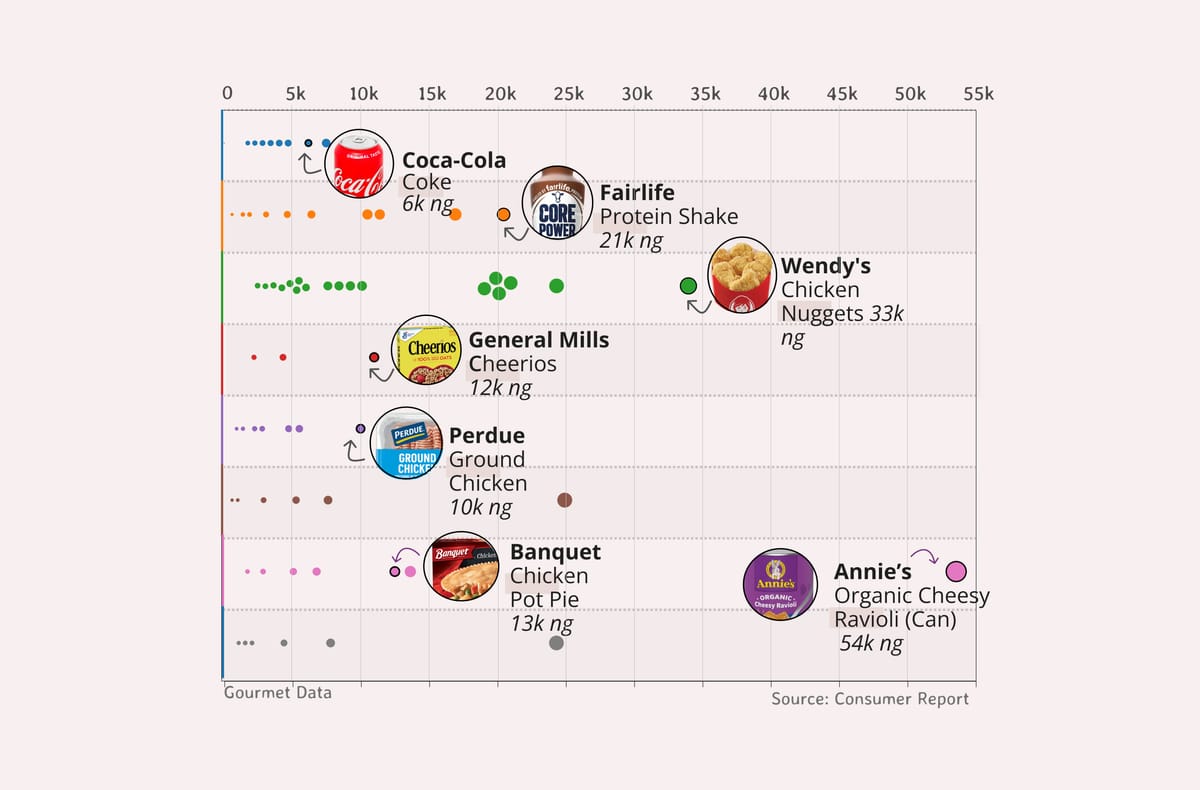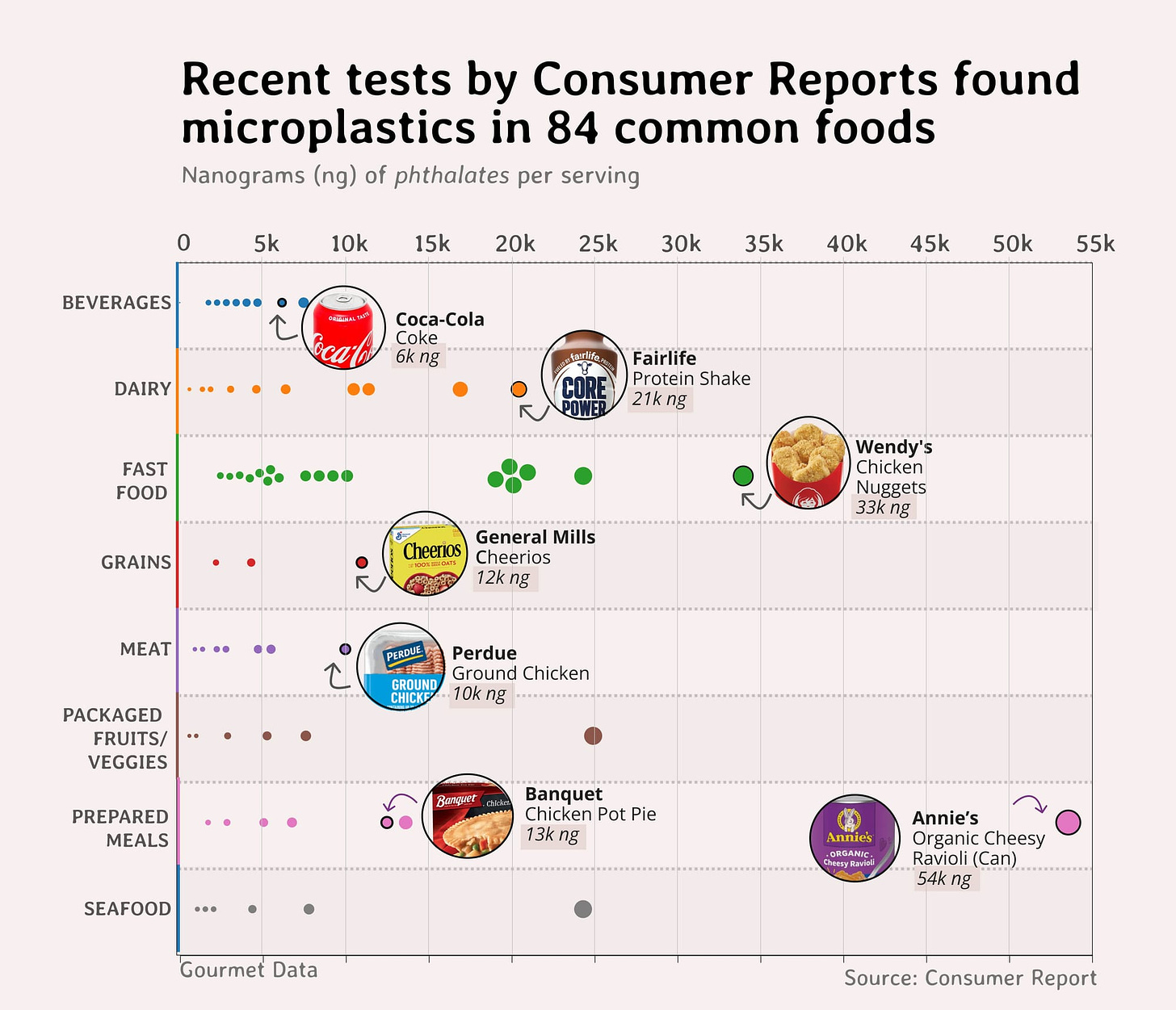Microplastics Found in Common Food Items

Gourmet Data is a blog where a data journalist breaks down questions. Subscribe either here on Ghost or on Substack.
Microplastics in Common Food
Recent tests by Consumer Reports on 85 foods show that phthalates and bisphenols are decently prevalent in the American food supply. Here's a methodology of their process.

What are the Reference Doses (RfD?)
Reading the report, the numbers are scary because many of the tested food items have recorded tens of thousands of nanograms of microplastics in the test. But I’d be lying if I said I really know what the actual numbers meant, so I looked it up, and came upon the EPA’s system of setting reference doses (RfD) for certain phthalates. In short, reference doses are estimated daily exposures of a chemical that is likely to be without risk of harm.
We can use that as a reference point.
To better understand reference doses, it’s helpful to walk through an example. There's a phthalate called DEHP, and, according to the EPA, it has a RfD of 0.02 mg/kg/day). That means, everyday, we should try to limit our intake of DEHP should be limited to .02mg of the substance per kilogram of body weight.
The data from Consumer Reports is reported in nanograms, so to further contextualize the report, we should try to convert the mg metric to micrograms (µg), and then convert that to nanograms.
- Convert the RfD (milligrams) to micrograms:God bless the metric system.
- 1 mg = 1,000 µg
- 0.02 mg/kg/day = 0.02 * 1,000 µg/kg/day = 20 µg/kg/day
- Convert phthalates per serving (nanograms) to micrograms:Technically, we need to do one more conversion.
- 1 µg = 1,000 ng
- 20,000 ng = 20 µg (as an example)
- Calculate safe consumption per day:
- Convert weight: 70 kg = 154.32 lbs
- Safe intake: 70 kg * 20 µg/kg/day = 1,400 µg/day
Thus, if I weight about 155 lbs, realistically, I should be able to eat 1,400 µg/day of DEHP a day without risk, which is about 1.4m nanograms/day. In reality, that’s equivalent to something like a grain of salt. One grain of salt weighs about 60 mg, so converting 1.4m nanograms to 1.4 mg, we get a mass of about 1/40th the weight of a grain of salt. A very, very small amount; no wonder they call it microplastics.
When factoring into how this puts the Consumer Reports in context, luckily, many of the foods don't reach that level on their own. Here’s a brief look:

How many phthalates are in our food?
I think most doctors would agree with me that the less plastics, the better, so while the recorded levels of some phthalates are in the tens of thousands of nanograms, the RfDs for those phthalates are in the millions.
The study tested for 10 phthalates (BBP, DBP, DiBP, DCHP, DEP, DEHP, DnHP, DMP, DiNP, and DNOP), and three chemicals used as phthalate substitutes (DEHA, DEHT, and DINCH). I tried my best to find as many of the RfDs as possible. Thus, for a 155lb person, here are your limits:
- DEHP: 0.02 mg/kg/day = 1.4m ng/day (link)
- DEP: 0.8 mg/kg/day = 56m ng/day (link)
- DBP: 0.1 mg/kg/day = 7m ng/day (link)
- BPA: 0.05 mg/kg/day = 3.5m ng/day (link)
- DIBP: 0.1 mg/kg/day = 7m ng/day (link)
- DINP: 0.059 mg/kg/day = 4m ng/day (link)
When lookin at the numbers, few make it past 35k of any one type of phthalate in one serving. Now, it’s technically possible for someone to eat ~50 servings of a certain food in a day, which would put the number of phthalates over some of the limits, but it would be very unlikely. However, the popularity of some of these food items recorded in the test are very popular, from Coca-Cola to Wendy’s chicken nuggets. It wouldn’t be the biggest surprise to understand how or why microplastics are present in ultra-processed foods.

Consumer Reports also found variations among similar products. The 33,980 phthalates in nanograms per serving in Wendy's Crispy Chicken Nuggets, for example, was more than four times the level in McDonald's Chicken McNuggets. So...I guess that's good news.
Thanks for reading!